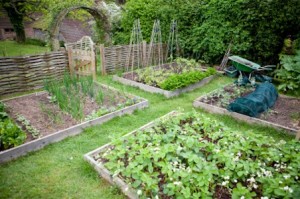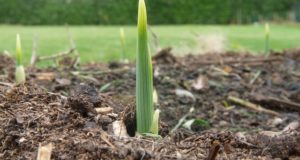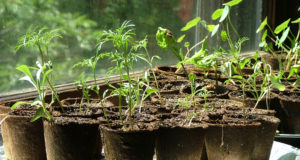 Old-timers in the garden will tell you that the best way to maintain healthy soil in your garden is to rotate your crops from one bed to another from year to year. Farmers from generations past knew that this practice would give them healthy soil for their children and their children’s children if the future generations followed in his footsteps.
Old-timers in the garden will tell you that the best way to maintain healthy soil in your garden is to rotate your crops from one bed to another from year to year. Farmers from generations past knew that this practice would give them healthy soil for their children and their children’s children if the future generations followed in his footsteps.
Practicing crop rotation is like getting back to basics. It is returning to the simple ideals of our forefathers. They grew their own food and knew that if the soil were to be depleted of its vitality they wouldn’t grow enough foods to provide for their families. By following their example, we can grow more produce in less space and have enough fresh veggies from our gardens to feed our families and share with others in our extended families and the community too.
Reasons For Rotation
There are several reasons to practice crop rotation, among them nutrient balancing, disease prevention, insect control, and nutrient fixing.
- Nutrient Balancing – each family of plants requires a different mixture of nutrients. By rotating your crops, you prevent the depletion of the soil and can make targeted choices for adding soil amendments to keep the soil balanced.
- Disease Prevention – this is the main reason for rotating crops. Growing the same plant families in a bed year after year causes a build-up of disease organisms; this will eventually result in crop failure. Rotation will keep organisms in check.
- Insect Control – rotation of your crops will help reduce infestations of insects in your garden.
- Nutrient Fixing – some plants actually fix nutrients into the soil. By rotating them through your garden beds, you can have your soil conditioned organically, and the best news is that this is a free side effect of the rotation process.
Crop families should not be planted in the same bed (or row) for more than three years in a row. This allows for a healthy balance of nutrients, organic matter, and microorganisms. Also, without crop rotation your garden yield will decline by up to 40 percent, mostly due to diseases. Studies from Connecticut, some European countries, and Cornell University have proven this statistic with tomatoes, other nightshades, and legumes. The Cornell study also went on to show that snap beans grown after corn doubled in production; but when planted after a previous snap bean planting, their production dwindled. The invisible world of the soil-dwelling micro-beings is what benefits the most from rotating your crops.
So keep in mind the needs of each family and the benefits they provide as you plan next season’s plantings. Beans and beets need manganese, whereas tomatoes crave tons of calcium, broad-leafed greens are wonderful for suppressing weeds, and the deep roots of corn are great for breaking up compacted subsoil.
Basic Rotation Schedule
Gardens of all sizes can be rotated. To get started, you can use a simple four-step plan that divides the sections by the portion of the plant that it is grown for: Leaves/Flowers, Fruit, Roots, and Legumes/Cover Crops.
Group 1: Leaves/Flowers
- Salad greens
- Lettuces
- Broccoli
- Cabbage
- Spinach
- Brussels Sprouts
Group 2: Fruits
- Tomatoes
- Peppers
- Eggplant
- Squash
- Corn
- Cucumbers
- Potatoes
Group 3: Roots
- Carrots
- Turnips
- Onions
- Beets
- Radishes
Group 4: Legumes/Cover Crops
- Beans
- Peas
- Peanuts
- Alfalfa
- Clover
New Survival Seed Bank Lets You Plant A Full Acre Crisis Garden!
Now that your groups are defined, you will rotate the groups through your garden beds in the following pattern.
- Even the smallest garden can be rotated by planted it in four sections and rotating the sections as follows.
- Legumes are nitrogen-fixing plants. By planting nitrogen-loving leafy veggies in their bed next year, it will reduce the amount of fertilizer they need.
- Root veggies help to break up the soil; this is why it is good that legumes follow them.
- Some vegetables aren’t as susceptible to disease – like lettuce, cucumbers, squash, and melons – so they can be planted after almost any other crop where there is ample space. But it is easier to plan your rotation schedule by rotating all your crops.
- You may want to practice rotating on a single bed, and when you get the hang of it you can add all of your beds into the plan
This pattern is a four-year cycle flows from year to year in the following order:
Year 1:
Area 1 Area 2 Area 3 Area 4
Leaves Fruit Roots Legumes
Year 2:
Area 1 Area 2 Area 3 Area 4
Fruit Roots Legumes Leaves
Year 3:
Area 1 Area 2 Area 3 Area 4
Roots Legumes Leaves Fruit
Year 4:
Area 1 Area 2 Area 3 Area 4
Legumes Leaves Fruit Roots
In year five, you start at year one again.
Rotating By Plant Family
Now that you have perfected the basics, you may be ready for a more advanced rotation plan. Starting to rotate by the plant families may suit your quest to a tee. Below are some common plant families that may be growing in your vegetable garden. Take what you have learned in the basic planting schedule and apply it to the different plant families here. When you begin this method, you should also remember to allow one bed each year to lie fallow—i.e., let it rest. This is a biblical principle that many gardeners have never heard of, but it is mentioned over and over throughout the first five books in the Old Testament. In the fallow year, you can plant a cover crop that will be tilled into the soil the following season, or can mix in a large amount of compost and/or other organic matter into the bed. While it is resting, it will be gaining nutrients from the cover crop or organic matter that will be beneficial to the crop that is planted in that bed the next season.
A Little About Plant Families
There are ten basic plant families in your garden: nightshades, legumes, gourds, brassicas, greens, the carrot family, the sunflower family, the goosefoot family, the grass family, and the onion family.
Nightshades – tomatoes, peppers, potatoes, and eggplants. Pests like tomato hookworm and/or diseases like blight are more inclined to attack your nightshades if they are planted in the same bed year after year. Additionally, these crops are heavy feeders that can deplete the nutrients in your soil in very few seasons.
Legumes – peas, beans, soybeans, and peanuts are legumes. While these are susceptible to some diseases and pests, the main reason we want to rotate our veggies is because this family is a nitrogen “fixer” – it increases the amount of nitrogen and other nutrients in your soil. This boost of nutrients is beneficial to the next planting in the bed where your legumes are planted now.
Gourds – summer and winter squashes, cucumbers, pumpkins, and melons. These family members are heavy feeders and will deplete the soil over time. They are also susceptible to several pests, including the squash bug, which lives through the winter down deep in the soil.
Brassicas – arugula, mache, broccoli, cauliflower, kale, cabbage, kohlrabi, turnip, rutabaga, radish, Chinese cabbage, collards, and Brussels sprouts are all brassica family members. They require high amounts of nitrogen, because it is what gives them their green color.
Sunflower family – Sunflowers (of course), Jerusalem artichokes (also called sunchokes), lettuce, salsify, and endive. This is a family of relatively light feeders, which grows best when followed by a heavier feeding family like the brassicas.
Carrot family – carrots, parsnips, celery, fennel, dill, and parsley. This family prefers lots of organic matter in the soil, but too much nitrogen causes disfigured growth. It is best not to plant them in the bed where your legumes grew last year.
Goosefoot family – beets, Swiss chard, and spinach. These will grow well almost anywhere, even in soil where fertility is low. They are a good family to plant in a bed following brassicas or nightshades.
Grasses – corn is a member of the grass family. It grows best in good quality, fertile soil. So it is a good candidate to plant in the bed where you previously grew your legumes. Or you can plant corn and beans together in the same bed this year—then your beans will feed your corn all season long.
Onion family – onions, leeks, garlic, shallots, chives, and scallions. This family is great at repelling pests. They also require soil that is very fertile. Planting them after your legumes is a good idea.
Record Keeping
When you start rotating you will need to keep records of what you grow in your beds each season and when you allow a bed to lie fallow. I have started keeping diagrams of my garden; pictures of the garden before, during, and after each growing season; and a list of what seeds I bought each year.
I have set up a notebook with dividers for each month and an archive section in the back where I have put dividers for each year. In each monthly section I put the diagram or garden blueprint and the pictures I have taken through out the year. I also make notes on what grew well, what the weather was throughout the season, and anything else that may catch my attention along the way. This notebook would also be the place for your rotation schedule. In December, I rotate this year’s records into the archive section for that year and start planning for next year. Having all of your garden records in one location will help your garden remain organized all year long. It will also allow you to plan ahead for next year and many years to come.
Rotate your garden and enjoy God’s bounty in your beds for years to come.
©2012 Off the Grid News
 Off The Grid News Better Ideas For Off The Grid Living
Off The Grid News Better Ideas For Off The Grid Living




